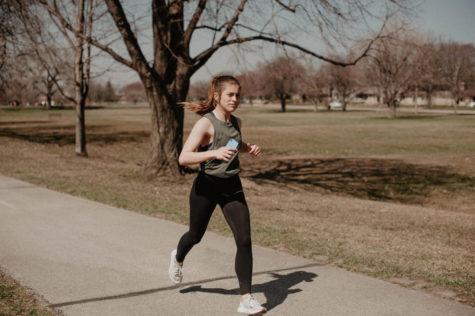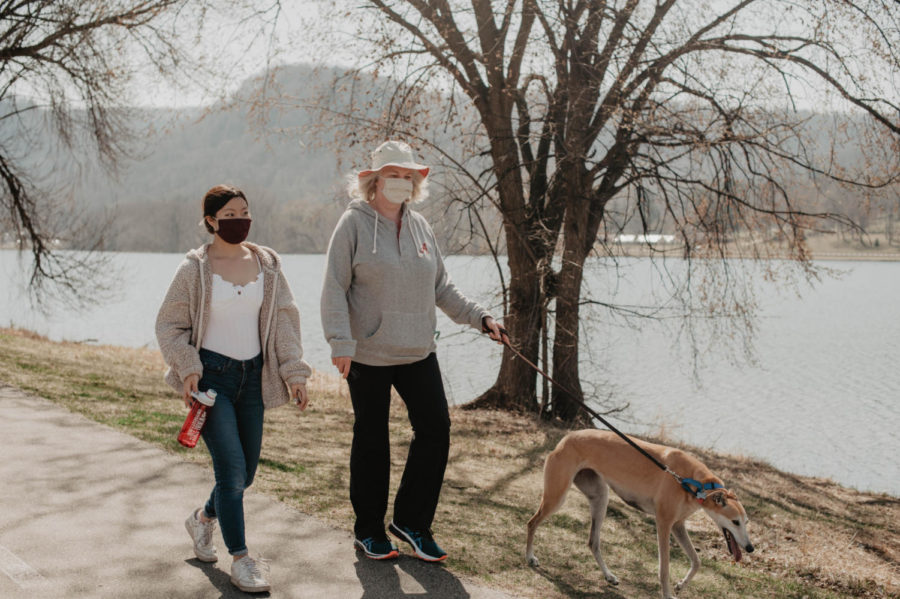Students & staff get creative to get moving during COVID restrictions
First-year student Macey Heath (left), her mother Caroline (right) and their dog walking on the path of Lake Winona Saturday morning. Heath said she maintains physical activity during COVID-19 by going to the rock climbing center and going on walks when weather permits.
April 7, 2021
Winona State University students and staff report changes to their physical activity routines because of COVID-19.
After over a year of working almost entirely online, being tethered to computers and staying at home, physical activity has been difficult to maintain for many.
Quarantine provided time to experiment with an abundance of at-home workouts, but students and faculty alike struggled with consciously and consistently staying active.
It is a difficult to acknowledge the feeling of being inactive yet unable to consistently head to the gym with the fear of spreading or catching COVID.
Janet Macon, a registered dietitian and nutrition instructor at Winona State for the past nine years, described reports from students that physical activity has been challenging to work into their days since the pandemic began.
“Students say they’re having to intentionally remind themselves to get up and move,” Macon said. “Otherwise, they tend to sit in front of their computer all day, particularly if all of their classes are online.”
Macon detailed hearing students unintentionally gaining weight and getting aches and pains from inactivity and students not leaving their room hardly at all because of online class or fear of getting sick.
Sitting at a desk for a extended periods of time staring at a screen is difficult on the body and mind, but students can combat a sedentary lifestyle by actively taking breaks to walk around or go up and down stairs, even in the library or in their dorms.
Logan Rupnow is a second-year movement science major entering the athletic training graduate program this summer at Winona State and also advised students to take study breaks.
“While I don’t have statistics, sitting at your desk burns fewer calories and could take years off your life,” Rupnow said. “A student can combat this by taking study breaks and getting their bodies moving. Not only does it help your mind, but it will make you feel good and healthy.”
Kent Hansen is an associate professor at Winona State in the movement science department and has utilized different tools to move his body while working at a desk.
Hansen uses a standing desk because standing uses more muscles, increasing energy expenditure. The standing desk helps to reduce the amount of time sitting and working for hours.
“It’s called the sitting disease,” Hansen said. “Even if you devote time to go and exercise, sitting for long periods of time may negate that exercise.”
At COVID’s peak, gyms were either closed or appointment-based and included COVID guidelines like social distancing and wearing masks. COVID has forced students to creatively find ways to stay active.
Gunnar Mach, associate director of both Fitness and Wellness and Strength and Conditioning, said COVID impacted student athletes’ ability to gather and train in-person, accounting for an overall loss of speed and power for those students without physical activity and closed gyms.
“We had done all this work for years at a time to build up to the physical standpoint we’ve been at, and then we came back [from quarantine] at extremely reduced physical fitness levels,” Mach said. “A lot of my kids are now getting back to where they were last year, and it shows what happens when you aren’t able to train the way we need to.”
Although Mach is not concerned with serious lifelong affects for students who were temporarily inactive due to COVID, he still encourages students to not completely stop being physically active as the pandemic continues.
“I know that [COVID has] forced me to look at being creative with keeping up my energy expenditure,” Hansen said. “COVID has gotten people out of their tunnel vision in terms of how they can be healthy and change their regular routine.”
In agreement with Hansen, Rupnow invited students to get outside more or follow at-home workouts.
“Doing at home workouts with body weight and little to no equipment is a great starting place for students,” Rupnow said. “I know people are doing more HIIT workouts, yoga at home and going outside for runs. COVID-19 made it tough at first, but students at Winona State have adjusted well and are really making a positive impact on their health going forward.”
Rupnow commented on gyms also being a stress reliever, saying strength and conditioning classes helped him to learn and adapt to the changes in working out.
“I learned new things,” Rupnow said. “I’ve never really been a runner before, but now I do a lot more running. I’ve kind of fallen in love with that. I guess I found different niches.”
Another student, fourth-year accounting major Jarred Schmitt, said he also began running during the pandemic.
Reopening the Integrated Wellness Complex (IWC) on campus was one of Winona State’s top priorities for students’ health and fitness while COVID continues.
“We really wanted to make sure that our fitness center was accessible and safe for students,” Macon said. “Our staff works double-time during COVID to educate students and build a culture of health and wellness.”
Jeff Reinhardy, Director of Fitness and Wellness at Winona State, commented on the difficulty in navigating the reopening of the integrated wellness complex under the guidance of the Minnesota Governor, Winona State’s Presidential Cabinet and the Center for Disease Control.
“We were asked to have restrictions on our numbers, hours, do reservations, move equipment around and tape off things to create spacing,” Reinhardy said.
The primary use of reservations is to track who is in the building at what time to help notify students if they were in contact with a potential exposure to COVID. Recently, the reservation system at the IWC is no longer being used. Similar to the Winona YMCA, students use their Winona State IDs to scan in, which marks the time they enter the gym.
“The reservation system was so cumbersome and not made to do what we’re asking it to do,” Reinhardy said. “It was nice when we were able to set that aside.”
Governor Walz has relaxed COVID restrictions, which helped extend the IWC’s gym hours, now including the weekends. Students can now go to the campus gym anytime between 10 a.m. and 8 p.m. during the week. Reinhardy hopes to have summer hours as close to a “normal year” as possible.
“We were asked to reduce hours, but now we’ve been able to open up a little bit more,” Reinhardy said. “Generally, in the summertime we’re open from roughly 6 a.m. to 8 p.m., and my hope is we’ll be very close to that this summer. We still have not been given a complete timeframe, but that is our hope at this point.”

Reopening the IWC has not been easy due to COVID precautions and guidelines, but Reinhardy and other staff members have done their best because physical activity for students and faculty is important, especially after months of access restrictions at the IWC.
“We appreciate the students’ patience,” Reinhardy said. “The people who dislike the situation more than the students, are us. I despised every day that we couldn’t be open, and it’s nobody’s fault. We’re really happy to see we’re close to what a typical timeframe looks like for us.”
According to the CDC, the general physical activity recommendation for adults is 150 minutes each week, which is thirty minutes of exercise five days a week. Mach advises students to hit the bare minimum for physical activity to maintain cardiovascular health and a healthy body weight.
“Students should cut their intensity from before in half and start there and work their way back up, maybe adding ten to fifteen percent each week or maybe even less, to build themselves up over time,” Mach said. “If you go from 100 to 0 back to 100, that’s where injury usually occurs, and that’s the big thing with our athletes. We really need to pace ourselves, take our time.”
Rupnow also explained how important mental health has been impacted by COVID and intentionally taking study breaks, meditating, eating healthy and working out are part of living a healthful lifestyle.
“People are meditating or doing all sorts of different things to really impact themselves,” Rupnow said. “So, I think mental health awareness and being able to change our old habits with some new healthier habits has been something I’ve noticed across campus as well.”
Winona State encouraged the implementation of mental health days to help students go outside, enjoy the outdoors and relax while giving them a break from class.
As a resident assistant in Maria Hall on West Campus, Schmitz supports his residents’ choice to take time away from their laptops and head outside.
“Bless WSU Health for letting us have mental health days and making sure we go outside,” Schmitz said. “It’s made me more aware of my residents to get some vitamin D and hopefully increase their productivity when they get back to work. It’s not the most ideal situation but there’s plenty of opportunities to go out and be active in Winona.”
As a nutrition professor, Macon tries to consistently encourage students to make their holistic health a priority, regardless of disruptions to the pursuit of healthy food choices and activities.
“Learning how to maintain that [holistic health] priority through any kind of challenge in life to create balance, whether we’re in a pandemic or not,” Macon said.














































